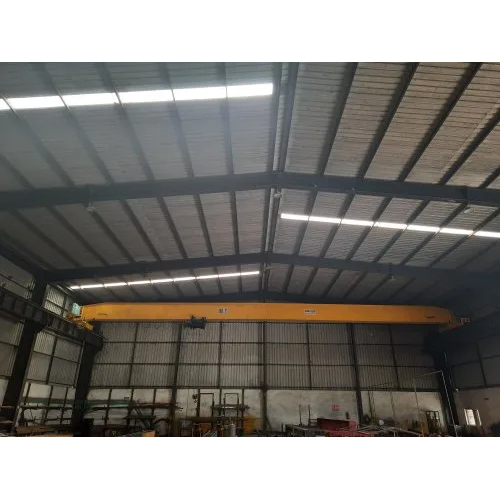
Simple Single Girder Crane
Product Details:
- Product Type Simple Single Girder Crane
- Condition New
- Power Source Electric
- Color Yellow
- Usage INDUSTRIAL APPLICATIONS
- Crane Type Single Girder Crane
- Application Construction Outdoor Yard
- Click to view more
Simple Single Girder Crane Price And Quantity
- 1 Unit
- 440000 INR/Unit
Simple Single Girder Crane Product Specifications
- Simple Single Girder Crane
- Remote Control
- INDUSTRIAL APPLICATIONS
- Construction Outdoor Yard
- Yes
- 1 Year
- Yellow
- Electric
- Single Girder Crane
- New
- 5 - 10 Tonne
Simple Single Girder Crane Trade Information
- Cash Advance (CA)
- 100 Unit Per Month
- 10 Days
- Asia Australia Central America North America South America Eastern Europe Western Europe Middle East Africa
- All India
Product Description
A single horizontal girder or beam is supported by end trucks on either side in a single girder overhead crane, commonly referred to as a simple single girder crane. It is frequently employed in a variety of applications to lift and move lighter items.
The main characteristics and parts of a straightforward single girder crane are as follows:
2. End trucks: At each end of the girder, there are end trucks that contain the wheels or tracks that let the crane move along the runway system. They give the crane construction stability and support.
3. Hoist: A trolley that moves along the girder's length is attached to the hoist mechanism. The lifting and lowering of the cargo is done by the hoist. Depending on the particular requirements, single girder cranes can be fitted with a variety of hoists, including wire rope hoists and chain hoists.
4. Trolley: Mounted on the girder, the trolley moves horizontally along the crane's length. It supports the hoisting system and enables accurate load location.
5. Control system: Single girder cranes frequently come with a control system that gives operators full control over the crane's movement and use. Features like pendant controls, push-button buttons, or radio remote controls could be part of the control system.
6. Safety features: Single girder cranes are outfitted with a variety of safety features to ensure safe operation. Overload protection, emergency stop buttons, limit switches, and audible or visible alerts are a few examples of these.
7. Single girder cranes are capable of being modified to meet certain needs and applications. Different load capacities, spans, lifting heights, and operating speeds can be incorporated into their design.
Common light-duty applications for simple single girder cranes include workshops, warehouses, and production lines. They offer a practical option for transferring and lifting lighter weights in constrained spaces. These cranes are appropriate for a variety of businesses that need effective material handling because of how simple they are to install, use, and maintain.

Price:
- 50
- 100
- 200
- 250
- 500
- 1000+
 Send Inquiry
Send Inquiry  English
English Spanish
Spanish French
French German
German Italian
Italian Chinese (Simplified)
Chinese (Simplified) Japanese
Japanese Korean
Korean Arabic
Arabic Portuguese
Portuguese


